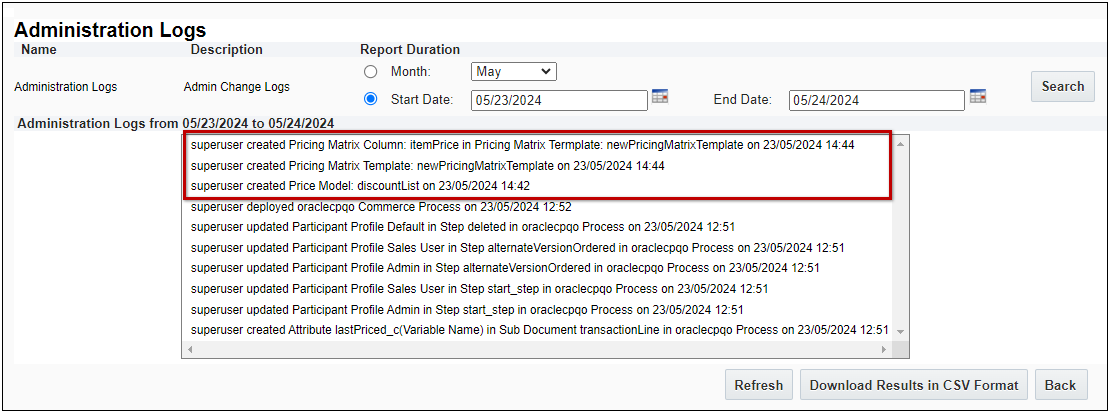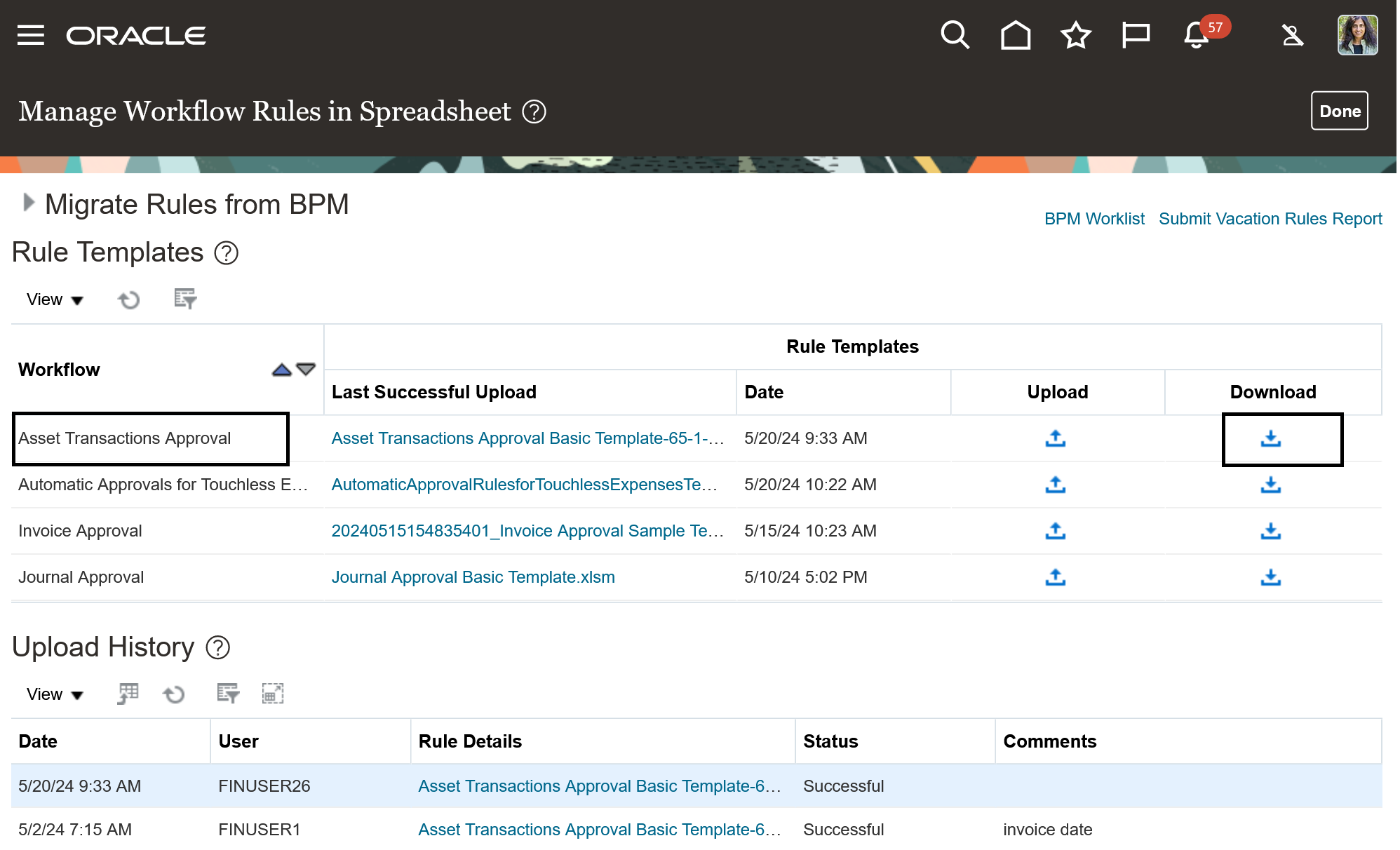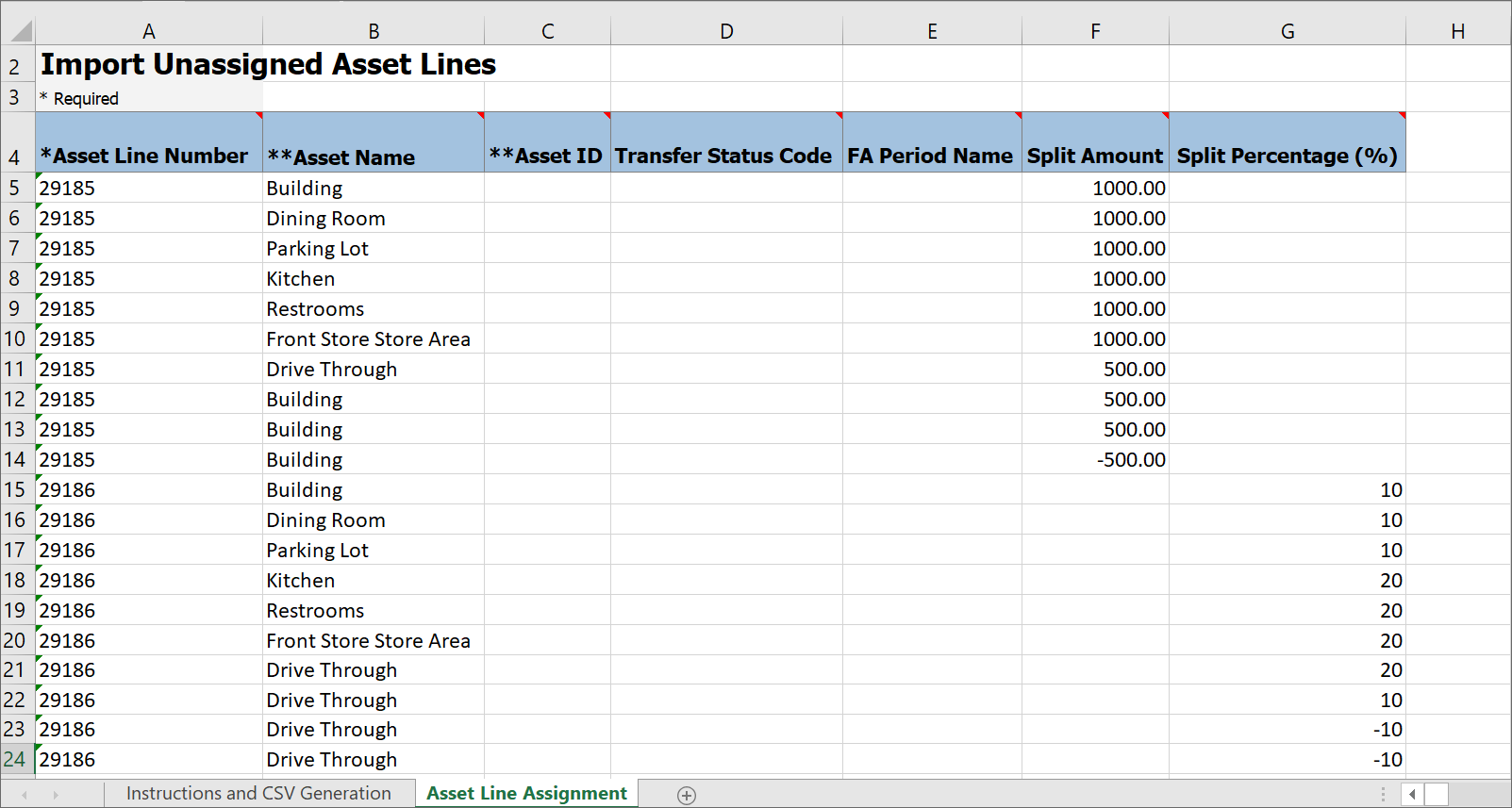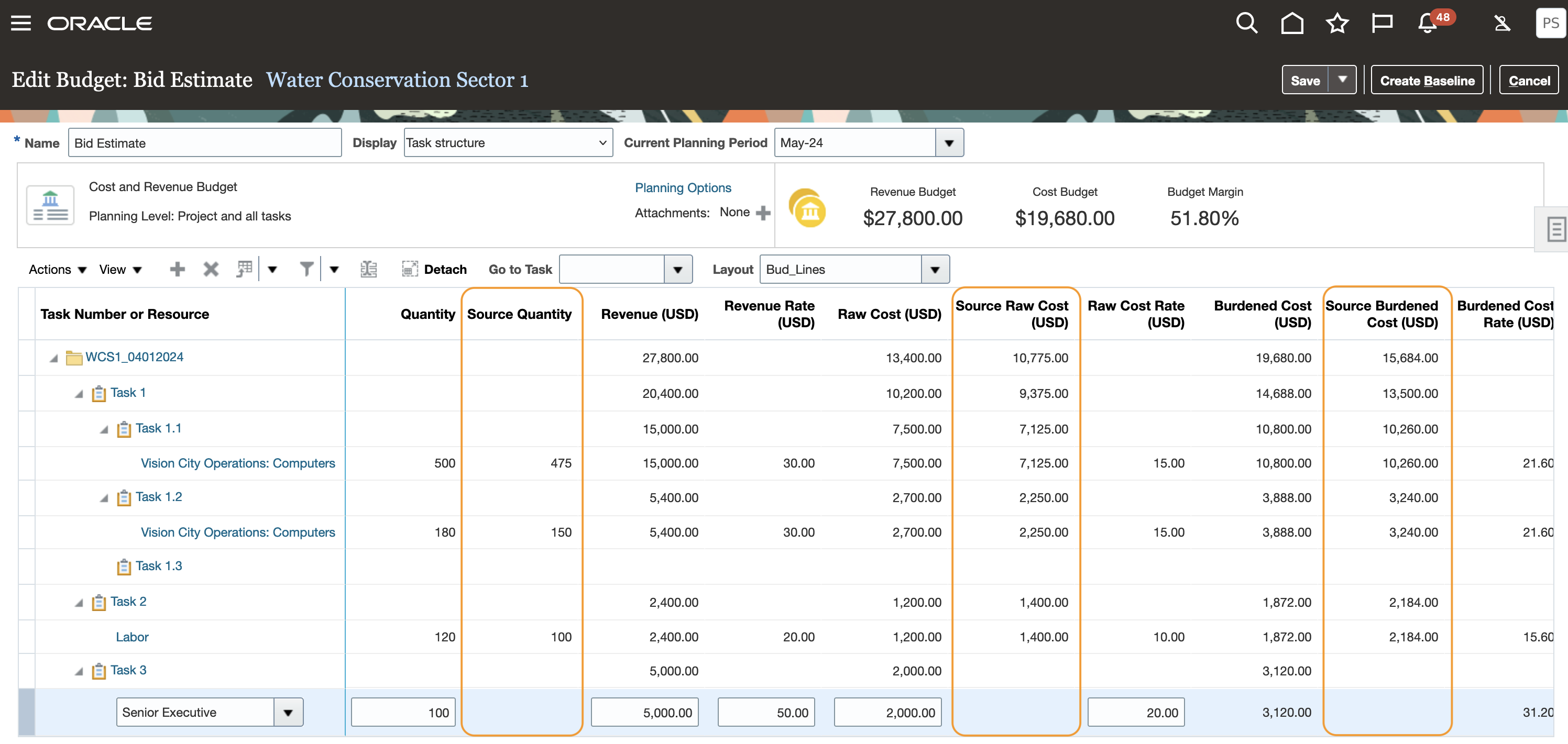UPDATE 2024 C
-
Common Technology/UI
-
Financials
-
Manufacturing & Supply Chain
-
Projects & Portfolio Management
Common Technology/UI
OTBI
Email a Link to Analysis Results
What it Does: Users can now create an agent that sends an email with a link to the results of analysis.
Why it Helps: Helps to share OTBI analysis results without sharing bulky files or confidential PII files to users in emails as attachments. Instead, users can receive a link to the results of the analysis.
Approvals and Notifications
New Features for Approvals Work Area
What it Does: Users can request information about an approval in the Details page. When users receive a request for information, they can reply to it or withdraw the task from the Approvals Tasks or Details page. Users can also reassign tasks in the Details page.
Why it Helps: It provides improved navigation to approval details and the ability to reassign, ask, and answer questions about approvals.
OSN
Oracle Social Network (OSN) is Retired
What it Does: You can no longer use Oracle Social Network (OSN) to share, socialize, and update information.
Why it Helps: This affects users across all product families who are using OSN.
Extensibility
Updated Oracle Visual Builder Studio: To Extend Application Pages
What it Does: Gives users options to:
-
- Bypass CI/CD pipelines for deployment
- Isolate extension workspaces or repositories by pillar and group dependencies
Why it Helps: This new feature enables faster and simpler deployment of extensions directly to your development environment without using CI/CD pipelines.
Updated Oracle Visual Builder Studio: To Improve
What it Does: Gives users:
-
- Support for selecting field values from a list of values (LOV)
- Improved support for standard functions and actions in the Advanced Expression editor
- Default value in business rules supporting LOVs
- Enhanced variable and type creation
Why it Helps: The feature gives users more advanced extensibility options in business rules and page properties.
Updated Oracle Visual Builder Studio: Automatic Saving of Changes to The Condition Builder in VB Studio
What it Does: When you modify business rules and validations in the condition builder, your changes will now be saved automatically.
Why it Helps: Improves productivity by preventing rework caused by not saving changes regularly and losing them due to system or connectivity issues.
Updated Oracle Visual Builder Studio: Auto-Selection of a Single Environment During Workspace Creation in VB Studio
What it Does: When your project has only one environment, it’s now automatically selected for you when creating a Visual Application or Application Extension workspace.
Why it Helps: Improves productivity while extending functionality using VB studio by eliminating extra steps.
CPQ
Commerce
Oracle Commerce Cloud Self-Service Portal – CPQ Integration
What it Does: Provides the ability to publish a quote from Oracle CPQ to the Oracle Commerce Cloud self-service portal to enable buyers and sellers to collaborate on a common open platform. Oracle Commerce Cloud buyers can add comments to the proposal for review and commenting by CPQ sales users, and those comments can be incorporated in the CPQ quote transaction.
Why it Helps: This enhancement provides options for better communication and tracking of changes between Customers and Sales agents. Comments are saved to the CPQ quote and/or the applicable transaction line items.
Pricing
Price Effectivity for Line Item Prices
What it Does: Allows price effectivity to honor a ‘price as of’ date is available for each quote line when pricing is re-evaluated, which was previously only available at the transaction level.
Why it Helps: You can now target specific lines for different pricing using ‘as of’ dates for record history.
Sarbanes–Oxley Data Compliance in CPQ Pricing
What it Does: Customers can enable logging of changes made to Pricing Engine values in the Administrative Logs. When enabled, changes to pricing made in the Pricing Portal, Product Workbench, or with any of the Pricing REST APIs are logged.
Why it Helps: This feature tracks which changes are made to pricing, who made them, and when the changes occurred. The information is then available to auditors, as needed.


Financials
General Ledger
Approval Assignees and Comments Displayed in the Journal Action Log
What it Does: Shows approval cycle and approval comments in journal actions.
Why it Helps: Without navigating transaction control/approval notifications, the approval life cycle can be viewed in the Journal action. This provides greater visibility on approval actions and enables users to react more quickly.
Accounts Payable
Automatic Completion of Printed Payment Files
What it Does: On the running payment batch, the action ‘Record Print Status’ will automatically perform on the ‘Record Check Print Status’ completion.
Why it Helps: This will automatically create the printed checks without user intervention to review the check printing status.
Invoice Creation for Remitting Escheated Payments to the Escheatment Authority
What it Does: Invoices are automatically created on the name of the escheatment authority for un-claimed checks.
Why it Helps: Manual invoice creation is no longer needed, and the appropriate accounting actions are also automated.
Fixed Assets
Exception-Based Approvals for Fixed Asset Transactions
What it Does: Approval processes can be configured for Fixed Asset additions, transfers, reclass, retirement and adjustment actions.
Why it Helps: This feature enables organizations to create workflows based on unique business requirements for asset transactions, which lead to better control on Asset Transactions.

Transaction Processing Order in FBDI Templates
What it Does: The Interface Line Number within the Adjustment in the FBDI template determines the order of processing for the assets with multiple transactions.
Why it Helps: Transactions are executed sequentially in the order of the interface line number. Users no longer need to create multiple FBDI files and process them according to the required order of transactions, which saves them time.

HCM
Global HR
Generate Representatives for Nonworkers
What it Does: Nonworkers can now see their representatives through self-service. Other users, such as Line Managers or HR Representatives, can also see the representatives of a nonworker. HCM processes such as Approvals and Refresh Representatives Data, now includes nonworkers.
Why it Helps: This feature enables the nonworkers to be treated the same as other employees, contingent workers, and pending workers.
Preview Document Record Attachments on Redwood Pages
What it Does: You can now easily preview attachments for document records on Redwood Document Records pages, without having to download them to a local folder. You can preview both reference info and document record attachments.
Why it Helps: Users have a quick preview on the document records page itself and don’t have to download the attachments locally to view them.




Family and Emergency Contacts Region Supported as Embedded Application Task in Journeys
What it Does: You can now include adding family and emergency contacts as an embedded application task with reduced navigation by using the Family and Emergency Contacts task region.
Why it Helps: This feature enables users to more quickly complete the Family and Emergency Contacts task with fewer clicks.
Benefits
Mutually Exclusive Plan Rules
What it Does: You can now enforce mutually exclusive plan rules in the Configure Plan Type Grouping Display page. For example, your enterprise has the Health Care FSA and Health Savings Account plan where employees can enroll only in one of the plans at a time. They need to disenroll from one plan to enroll in the other plan. This enhancement ensures that participants can enroll in one mutually exclusive plan at a time. For the mutually exclusive plan rules to work well, all such plans must be in the same plan type grouping.
Why it Helps: This enhancement improves the self-service benefits experience and reduces the number of fast formulas needed.

Compensation
Rates-Based Salary Basis Type Introduction
What it Does: You can now maintain salaries using the new “rates-based” salary basis type, built on the Oracle Fusion Cloud Global Payroll rates engine. The new salary basis type lets you maintain individual rate components, which can have their own characteristics, such as a periodicity and currency.
Why it Helps: This feature lets you reduce operating costs by flexibly maintaining salary in the exact way you offer it.



Absence Management
Donation Pools
What it Does: Allows you to configure an absence plan with type of “Donation Pool“.
Why it Helps: Employees can donate accrued hours to the pool which is maintained as a monetary fund by Payroll. When employees require additional PTO hours, they can request from this pool which then must be approved.
Time and Labor
Redwood Time Card Enhancements
What it Does: This feature introduces the following enhancements:
-
- Row Level Comments
- Sorting
- Display scheduled hours
- Resizing columns
Why it Helps: Employees and managers can now add comments to each row in the timecard, sort the timecard by time type or assignment, display their scheduled hours for the week above the timecard, and they can resize their timecard columns which will then save for future use.
Time Card Templates
What it Does: Allows you to save a timecard as a template.
Why it Helps: If you have a complex timecard entry every week but it remains relatively the same, you can now create it one time and save it as a template for future use.
Global Payroll
Deletion of Time After Termination Date of Employee
What it Does: When an employee is terminated, all time entries in the Payroll application dated after the termination date are now automatically deleted.
Why it Helps: HR users and line managers now don’t need to manually delete time entries that exist after an employee’s termination date or run a script to delete them.
Redwood Experience for Payment Results
What it Does: The Payment Results page has been moved to the Redwood toolkit. This new page allows you to quickly view and manage an employee’s payment results.
Why it Helps: The redesigned Payment Results page enables users to:
-
- View an employee’s payment details for a payroll run
- Identify the status of the payment such as unpaid, paid, void, etc.
- Perform corrective actions based on the status of the payment (for example, you can either roll back or void a paid payment)
- Initiate further actions like Make External Payment and enter external payment information against an unpaid (or voided) prepayment record
Redwood Experience for Personal Payment Methods: View Corrections
What it Does: You can now view all the corrections made to a personal payment method in Redwood. The history section on the Personal Payment Method page lists all the effective-dated updates to the personal payment method since it was created.
Why it Helps: When you have auditing on personal payment methods enabled, you can drill down into an effective-dated personal payment method record to view all the corrections made to that record in the Summary of Changes page.
Redwood Experience for:
- Person Messages
- Flow Submission
What it Does: The Person Messages and Submit a Flow pages have been moved to the Redwood toolkit, giving the page the look of Redwood, along with the backend functionality that Redwood offers.
Why it Helps:
Person Results – Enables a task to directly search for an employee and use the Actions menu to open the Messages page for the employee.
Submit a Flow – With this new page you can now submit a flow, process, data load, or report.
Distributed Element Name as Subledger Accounting Source
What it Does: You can now view the name of the distributed element in the results for the subledger accounting process.
Why it Helps: When the costs for an element are distributed, the name of the distributed element is now displayed on the journal line.
Additional Information in Costing Results UI and Costing Results Report
What it Does: You can now view the status of the Transfer to Subledger Accounting and Import Payroll Costs processes for each payroll costing result.
Why it Helps: The Costing Results page and Costing Results Report now indicate which costs have been transferred to Subledger Accounting. You can also identify the import status of a cost result as part of Labor Distribution Integration.
Recruiting
Authenticate Email and Phone Number Sign In
What it Does: Returning candidates are now only allowed 4 attempts to authenticate date of birth or last name during sign-in using either email or phone number. If they fail to provide the correct details after 4 attempts, all buttons and fields are disabled on the Confirm Your Identity window, except for the create a new profile link. Candidates can use that link to create a new profile and claim the email or phone number. Alternatively, candidates can wait 30 minutes to try the sign-in process again.
Why it Helps: This feature provides better security for the email and phone number authentication during sign in.


Set Content Section Blocks in Apply Flow as Mandatory
What it Does: You can now set content section type blocks as mandatory to ensure that external candidates provide information. This applies to two types of blocks:
-
- Profile (Education, Experience, Licenses, Languages, and Skills)
- Timeline
This feature is supported in all application flow types: Apply, Event, Request Information, and Talent Community.
Why it Helps: This feature allows organizations ensure they collect all the information they need from a candidate in the application flow.


Compose Email and Text Messages Using AI Assist
What it Does: Draft emails and text messages to candidates faster and in a personalized way by using Oracle’s AI Assist feature, available as part of the new Redwood experience. This feature helps you quickly draft emails or text messages for various tasks in the hiring process, such as inviting candidates to apply for jobs, sending reminders or follow-ups, onboarding candidates, etc.
Why it Helps: Leverage the power of generative AI to enhance your email and SMS communications with candidates, while also saving time in drafting messages.
Goal Management
Redwood: AI-Suggested Goals Based on Previous Performance Evaluation
What it Does: While creating performance or development goals, workers and managers can view and add AI-suggested goals based on comments entered by the manager in the previous performance evaluation.
Why it Helps: Leverage the power of artificial intelligence to create effective and relevant performance and development goals based on the previous performance evaluation.
Performance Management
Check-Ins Between Managers and Indirect Reports
What it Does: Managers can now create a Performance check-in for an indirect report. When creating a check-in for an indirect report, the manager’s name defaults as the check-in manager and cannot be changed.
Why it Helps: This feature provides the flexibility for employees to schedule check-ins with other managers, and managers to schedule check-ins with indirect reports.



Manufacturing & Supply Chain
Purchasing
Search for Requisition Lines Using Item Source
What it Does: This feature enables buyers to search for requisition lines based on the item source, such as the local catalog, punchout catalog, noncatalog request, or extended contract items.
Why it Helps: Using this feature, buyers can quickly identify the requisition lines created from different item sources and process them into a negotiation or purchase order with appropriate values.

Configure Approval Rules for Purchasing Documents Using Mapping Sets
What it Does: This feature allows the configuration of approval rules using mapping set attributes. Companies can use mapping sets to configure approval authority by associating attributes from one or more dimensions and route SSP & purchasing documents for approval to the approvers defined in the configuration.
Why it Helps: This feature helps configure high-volume requisition and purchasing approvals using mapping sets instead of defining each rule for each distinct combination of approval parameters, such as the number of locations, departments, and categories. This feature significantly reduces the maintenance overhead associated with managing many rules.
Receiving
Create Receipt Returns for Expense Destination Transfer Orders
What it Does: This feature allows you to return transfer orders back to the original source inventory organization or source sub-inventory associated with the transfer order.
Why it Helps: This feature provides better control of your organization’s material and cost savings by allowing you to return internally transferred goods that are no longer required, even if they were expensed upon receipt.




Create Receipt Returns Using a Sub-Inventory That’s Not Quantity Tracked
What it Does: This feature enables the creation of a receipt return using a subinventory that’s set up as “not quantity tracked”.
Why it Helps: This feature provides you with more accurate cost tracking and more efficient material control by allowing you to create receipt returns for goods that are received into a sub-inventory that’s not quantity tracked.



Shipping
Pick and Pack Shipment Lines that are Pending Transportation Planning
What it Does: This feature allows companies to more accurately plan the transportation of goods when integrating to a transportation management system and shipping goods with variable weights, volumes, and dimensions.
Why it Helps: Usually when Oracle Shipping was integrated with a transportation management system, shipment lines were only eligible for picking and packing after the transportation plan information was sent back from the transportation planning system. Now, users can pick and pack shipment lines even when they’re still pending transportation planning.
Manufacturing
Define Additional Outputs in Discrete Manufacturing Work Definitions and Work Orders
What it Does: This feature lets you define additional manufacturing outputs (co-products and by-products) in new or existing standard work definitions. These outputs can be added for standard and nonstandard work orders to count point, automatically transact, and optional operations. They can be reported as an output completion transaction into a specified completion sub-inventory from the Review Dispatch List page.
Why it Helps: Prior to the introduction of this feature, each manufacturing process could only produce one output. Additional outputs to be either reused in additional operations or sold as a separate item had to be completed with ad hoc outputs. Now multiple outputs can be easily added to new or existing work definitions.


Consider Minimum Transfer Quantity in Work Order Scheduling and Lead Time Calculation
What it Does: This feature allows you to create and perform certain update actions on work orders that trigger unconstrained scheduling or rescheduling with consideration for the minimum transfer quantity to overlap operations and operation resources. By using a work definition with a minimum transfer quantity and selecting the default scheduling method, you can perform forward, backward, and midpoint scheduling for a work order through the UI, using a REST API and File-Based Data Import.
Why it Helps: By considering a minimum transfer quantity in work order scheduling, we can start the next operation parallelly once the minimum transfer order quantity is fulfilled. Before the work order’s operation, the user must calculate the transfer order quantity based on the operational capabilities to avoid bottlenecks.


Define Operation Yield at Work Definition to Model Expected Quantity for an Operation in Discrete Manufacturing
What it Does: This feature allows users to add yield percentages other than the default of 100%. These percentages can be specified for any operation in a new or existing work definition for discrete manufacturing and then used in calculating the work order material and resource requirements.
Why it Helps: Enabling this feature allows production to consider the expected loss at the operation level and would correctly estimate the production quantity required to meet demand and the cost of the final product.
Supply Planning
Plan Multiple Outputs from a Discrete Manufacturing Work Definition
What it Does: This feature allows Oracle supply planning and production scheduling to support discrete manufacturing work definitions or work orders that generate multiple output products in addition to the primary one.
Why it Helps: This feature helps plan for the primary and additional products (co-products or by-products), facilitating responses to the discrete manufacturing demands.
Production Scheduling
Consider Shift Exceptions in Scheduling
What it Does: This feature allows Oracle production scheduling to consider resource shift exceptions during schedule calculation.
Why it Helps: This feature helps result in a more accurate and executable schedule, which will help to efficiently plan the resources.



Projects & Portfolio Management
Billing and Revenue Management
Service Excellence Continuing Investments for Billing and Revenue Management
What it Does: Introduces the following features:
-
- Credit Memos for LOC-enabled Awards
- Cancel Project Contract Invoice REST API
- Flexible Billing Event Adjustment Processing
- Receivables Transaction Type in the Project Contract
- Improvements to Real-Time WIP Reporting
Why it Helps:
-
- Improves operating efficiency for LOC-enabled awards and billing event adjustment processing.
- Expanded OTBI reporting to track and manage WIP billing.
- Allows Project Invoice Cancellation with a REST API.
Cost Management & Control
Budgetary Control at the Project Task or Lowest Resource
What it Does: Control spending based on the budget allocated to project tasks, either at the top or lowest task of the work breakdown structure.
Why it Helps: This feature improves the strategy to control spending at a granular level. This reduces the risk of overspending and promotes the successful delivery of projects within a budget.
It also improves monitoring of costs to bring attention to potential changes to the organization’s budget and improves decision-making when using the clear, easy-to-understand user interface to define spending controls.
Project Asset Management
Mass Split of Project Asset Lines
What it Does: Users can use the Import Unassigned Asset Lines file-based data import workbook to split project asset lines either by amount or percentage.
Users can split large numbers of assigned and unassigned project asset lines into multiple asset lines.
Why it Helps: This new feature offers the following benefits:
-
- Increases efficiency by eliminating the need to make numerous project asset line splits and allocations individually in the Project Assets work area.
- Increases productivity by allowing project asset lines to be split and allocated to multiple project assets by amount or percentage concurrently.
- Reduces operational errors by automating the rounding of amounts by currency.

Planning, Scheduling, & Forecasting
Source Quantity and Amount Columns on the Edit Forecast and Budget Version Pages
What it Does: This feature expedites project budgeting and forecasting by adding columns for source quantity and amounts.
Why it Helps: Users can add columns to quickly compare the source for a forecast and with the ETC, making it easier to spot variances and make more informed decisions. It also allows easier management of budgeting and forecasting information on the budget and forecast lines.

Service Excellence Continuing Investments for Planning, Scheduling, and Forecasting
What it Does: Improvements are available in the following areas:
-
- Automatic inclusion of Project Costs and Revenue on copied forecasts
- Deferred mode for cascading project date changes to the project plan
- Microsoft Projects 2021 Integration
Why it Helps: These changes reduce the number of steps for project administrators to include project costs or revenue in a copied version. They enable project managers to report on and track changes in detail and easily share reports with stakeholders.
Microsoft Projects integration ensures continued support for project managers and administrators.
Resource Management
Rate and Person Type Filters for Evaluating Matching Resources
What it Does: Users can filter and select resources based on target rates or person type.
Why it Helps: Resource managers can precisely narrow the set of candidates based on target cost and bill rates. This helps resource managers maximize employee utilization by letting them pick employees over contingent workers.





